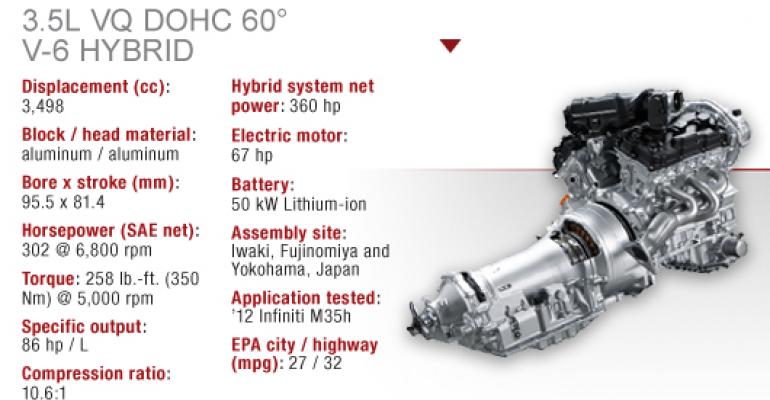It is fair to say Nissan’s previous efforts in the area of hybrid-electric vehicles have been half-hearted.
The Nissan Altima hybrid, which arrived in 2007, borrowed Toyota technology and landed in the U.S. market with a thud.
This time around, Nissan takes its time in developing its first home-grown hybrid system, a sophisticated, premium-priced unit that powers the luxury flagship Infiniti M35h sedan to a Ward’s 10 Best Engines award for 2012.
There are multiple reasons to tout the Infiniti Direct Response Hybrid system as a spectacular technological achievement.
First and foremost, the gasoline engine can be completely decoupled at any time, allowing it to shut off while a single 67-hp (50-kW) electric motor effortlessly propels the fullsize sedan, fed by a 346V lithium-ion battery pack.
In real-world driving, on a holiday road trip to the East Coast, the M35h happily depowers its 302-hp V-6 during steady-state cruising for up to a minute, even at speeds above 70 mph (113 km/h).
Toyota’s ground-breaking Hybrid Synergy Drive system cannot do that. To run at highway speeds, the Prius’ gasoline engine must be connected.
At slower speeds, the Infiniti system allows the engine to shut down more often – basically anytime the accelerator is released. By the end of our testing, the M35h was running in electric mode 16% of the time.
Further cementing the M35h’s credibility is the 30 mpg (7.8 L/100 km) fuel-economy average we saw at the end of a 2-week loan. That type of mileage in a large sedan is remarkable, especially when compared with much more expensive hybrids, such as the BMW 7-Series, Mercedes S-Class and Lexus LS.
With a base price of $53,700, the M hybrid is not cheap, but it’s a bargain compared with its German and Japanese rivals.
The functioning of the 7-speed automatic transmission must not be overlooked as a component of the Nissan system. Gear shifts are smooth and precise, and transitions between gas and electric modes are seamless.
There is no fussiness along the way, even though two clutches and an electric motor are packaged within the bell housing. If nothing else, Nissan engineers deserve kudos for excellent noise, vibration and harshness mitigation.
The M35h appears to set the template for Nissan’s fuel-efficiency plans for the future: A front-wheel-drive hybrid from the Japanese auto maker will debut in North America in 2013. There’s no word yet whether it will carry over certain Direct Response Hybrid technologies.
The M35h can be driven in three modes: eco, standard and sport. Each provides a different level of throttle response and fuel efficiency.
In sport mode, the car is decadently fast, a far cry from the poky hybrids we’ve come to know over the past decade. How many hybrids let you chirp the tires?
“Not many cars, if any, have this kind of power and get over 30 mpg,” writes Associate Editor Byron Pope on his scoresheet.
The hybrid powertrain produces 360 hp, but most of that comes from an engine that needs little introduction for long-time readers of Ward’s 10 Best Engines.
Yes, the naturally aspirated, port-injection VQ V-6, which spent 14 consecutive years on the Ward’s 10 Best Engines list, is at the heart of Nissan’s first internally produced hybrid.
This engine gives the M35h the nicest exhaust rumble of any hybrid that fits under our price cap. The VQ continues to set our hearts racing.




